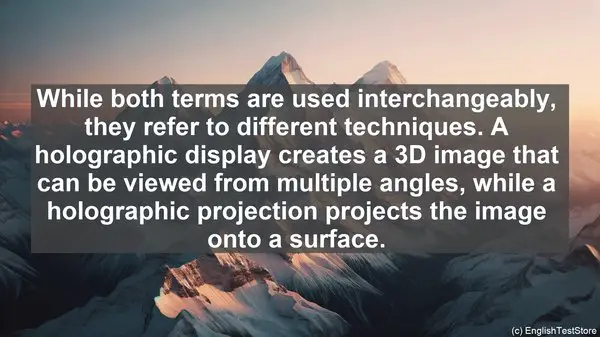Introduction
Today, we’re diving into the fascinating world of holographic technology. But before we start, let’s clear up some commonly confused words that often come up in this field.

1. Hologram vs. Holograph
While these words sound similar, they have distinct meanings. A hologram refers to the 3D image itself, while a holograph is the recording or the medium used to create the hologram.
2. Augmented Reality vs. Virtual Reality
Both AR and VR offer immersive experiences, but they differ in how they blend the digital and real world. Augmented Reality overlays digital elements onto the real world, while Virtual Reality creates a completely simulated environment.
3. Transparency vs. Opacity
In holography, transparency refers to the ability of light to pass through a material, while opacity means it cannot. These properties play a crucial role in creating holographic effects.
4. Reflection vs. Refraction
When light hits a surface, it can either reflect or refract. Reflection is the bouncing back of light, while refraction is the bending of light as it passes through a medium. Both are essential in holographic displays.
5. Resolution vs. Pixel Density
Resolution refers to the number of pixels in an image, while pixel density is the number of pixels per inch. A high resolution is crucial for sharpness, but pixel density determines the level of detail.
6. Interference vs. Diffraction
Interference occurs when two or more light waves combine, resulting in constructive or destructive interference. Diffraction is the bending of light waves around an obstacle. Both phenomena are fundamental in holography.

7. Parallax vs. Perspective
Parallax refers to the apparent shift in an object’s position when viewed from different angles. Perspective, on the other hand, involves the relative size and position of objects in a scene. Both contribute to the realism of holograms.
8. Monochromatic vs. Polychromatic
Monochromatic light consists of a single color or wavelength, while polychromatic light contains multiple colors. The choice of light source can impact the quality and vibrancy of holographic images.
9. Coherence vs. Incoherence
Coherent light waves have a fixed phase relationship, resulting in interference patterns. Incoherent light, on the other hand, has random phase relationships. Coherence is crucial for high-quality holography.
10. Holographic Display vs. Holographic Projection
While both terms are used interchangeably, they refer to different techniques. A holographic display creates a 3D image that can be viewed from multiple angles, while a holographic projection projects the image onto a surface.
